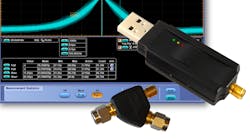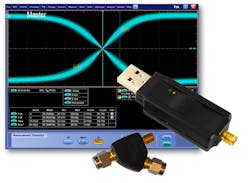Pocket-Sized Instrument Packs TDR and Fast-Edge Generator
Test instruments have traditionally been found in 19-in.-wide equipment racks, weighing too much to easily move about the laboratory or production floor. To combat that, a recent industry trend has been to shrink the size of high-performance test equipment.
One such development is the PerfectPulse Fast Edge Signal Generator from Picotest Corp. It provides square waves with 32-ps rise and fall times and the pulse edges needed to precisely measure things like cable and printed-circuit-board (PCB) transmission-line lengths and impedances, and even the dielectric constant of PCBs and other materials. For all of its capabilities, the PerfectPulse generator is remarkably compact, small enough to fit in a shirt pocket.
1. The fast rise and fall times of the PerfectPulse signal generator, as shown on this 70000 series oscilloscope from Tektronix, make it suitable for calibrating test probes and for TDR measurements on cables and circuit traces.
The PerfectPulse signal generator (Fig. 1) generates pulsed output signals at 50 mV and 50 Ω with no overshoot or undershoot—the kind of square waves that are extremely useful for performing time-domain-reflectometry (TDR) and time-domain-transmission (TDT) measurements utilizing a high-speed, real-time oscilloscope with sufficient bandwidth. The signal generator will be shipped with a 10-GHz power splitter so that the dual test signals can be used for high-performance TDR and TDT measurements on PCBs and PCB signal traces, as well as to measure the lengths of cables and signal traces, plus verify the quality of crimps in cables.
The J2151A PerfectPulse signal generator can be used for oscilloscope probe calibration. The compact signal generator is compatible with all 50-Ω probes, for convenient signal injection and noninvasive stability measurements on circuits. It works with a high-speed probe such as the Picotest model P2100A PDN Probe to measure PCBs on a 1-to-2-GHz real-time oscilloscope (RSO). The one-port P2100A test probe (Fig. 2) supports connections to 1.5 GHz with almost no capacitive loading: less than 1-pF capacitance, and typically only 420-fF capacitive loading.
2. The one-port P2100A test probe has a better than 1-GHz bandwidth and can be used with the PerfectPulse signal generator for noninvasive circuit TDR and TDT testing.
For the signal generator, simple single-button operation makes it possible to select different operating frequencies with settings for square waves at 1, 10, and 100 kHz, as well as 1 and 10 MHz, in addition to ground and dc output settings. The signal generator uses a 3.5-mm coaxial connector with its wide bandwidth and durability for added reliability. The connector type has been found to support more mating cycles than either 2.92-mm or SMA connectors.
The J2151A PerfectPulse signal generator produces output pulses of −500 mV at 50 Ω, trimmed to 1%. The signal generator is USB-powered, drawing typical 100-mA operating current. It can be used with a battery or a USB charger as a power supply. Included is an evaluation board with different reference circuit traces for TDR testing. P&A: $3500; stock.
Picotest Corp., Phoenix, AZ 85085; (877) 914-PICO, [email protected]



